Discover 35 hidden attractions, cool sights, and unusual things to do in Guangzhou (China). Don't miss out on these must-see attractions: Memorial of the Huangpu Military Academy, Sacred Heart Cathedral, and Chen Clan Ancestral Hall. Also, be sure to include Temple of the Six Banyan Trees in your itinerary.
Below, you can find the list of the most amazing places you should visit in Guangzhou (Guangdong).
Table of Contents
Memorial of the Huangpu Military Academy
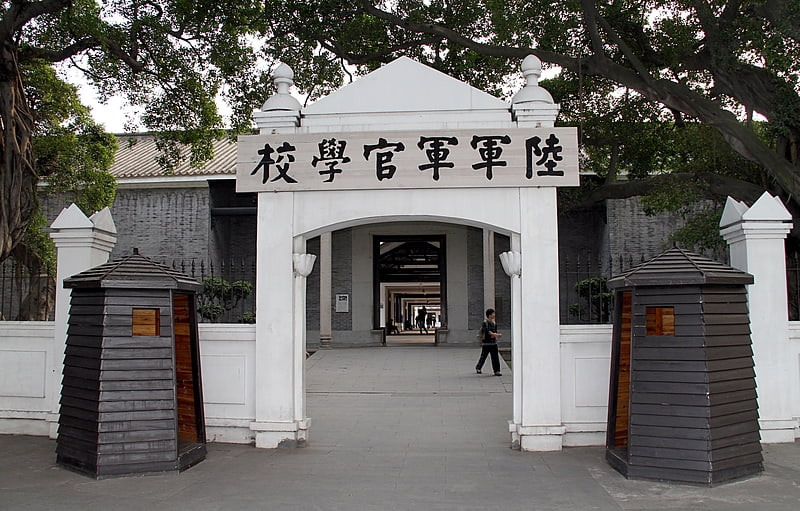
The former site of the Whampoa Military Academy is located in the Huangpu District of Guangzhou, China, on the island of Cheung Chau, formerly the Qing Dynasty Army Primary School and Naval School building.On June 16, 1924, Sun Yat-sen, with the help of Soviet advisers, founded the school to train military cadres Chinese Nationalist Army Officers School, which was later renamed the Republic of China Army Officers School to date.
The school is commonly known as the Whampoa Military Academy because it is located on the island of Cheung Chau in Whampoa. The military academy operated here until the seventh term, then moved to Nanjing in September 1930, and later to Chengdu and Kaohsiung.
Whampoa Military Academy gate above the center of the horizontal plaque on the Tan Yanjin book "Army Officers School" a few big words. At the entrance of the second door hangs "kill the enemy to stop, complete the revolution to turn back" couplet, the right wall of the second door hangs Chiang Kai-shek handwritten school motto "Dear sincerity". Whampoa military school headquarters is a day-shaped two-story brick structure, three roads four, corridors connected to the building. When the military school was founded, in front of the ancestral hall gate of the former Army Primary School, a European-style gate was added. Zhongshan's former residence is the "historical monument showroom", with a floor area of 805 square meters, which was restored in 1952 and was originally the General Taxation Department of the Qing Dynasty. Located in the former residence of Dr. Sun Yat-sen west of the student club is a European-style red building, the auditorium podium in the center and on both sides were hanging Sun Yat-sen statue, the legacy of the Prime Minister, the Chinese Nationalist Party flag, the Republic of China flag and Lin Zexu burning opium, the Boxer Rebellion.
The Tomb of the Fallen Martyrs of the Eastern Expedition is located in Pinggang, southwest of the military academy, covering an area of more than 50,000 square meters. It was built in 1925 by the military government of the Republic of China to commemorate the fallen soldiers who crushed the Chen Jiongming rebels and was completed in June 1926, with the remains of 516 martyrs buried. In front of the cemetery, there is the Memorial Square for the Fallen Martyrs of the Eastern Expedition built in 1928, which is a triumphal arch-style building covered with glazed tiles of national characteristics, with large letters written by Chiang Chung-cheng. In 1936, the East March Martyrs' Memorial Square and the pier were added to the main gate of the cemetery, which is known as the small Huanghuagang. The cemetery was destroyed during the Cultural Revolution and was repaired and restored in 1984. To the south of the campus, there is the Kyo-Shi Pavilion and the Northern Expedition Monument. The monument is more than 7 meters high and was built to commemorate the soldiers who died in the Northern Expedition. To the southwest of the campus, a theater-style club was built with a swimming room on its west side.
At the top of Bagua Hill behind the military academy, there is a 40-meter-high monument to Premier Sun, which was laid in 1928 and completed on September 26, 1930, with a 2.6-meter-high bronze statue of Premier Sun, weighing more than 2,000 pounds. The front of the monument is "Sun Yat-sen Memorial Monument" in six large characters in clerical script, the back is the statue of the Premier, the east is the Premier's legacy, and the west is the Premier's opening speech. The wall where the stairs from the bottom to the top of the mountain are located is decorated with stone, and the four words of the school motto "Dearness and Sincerity" are inlaid on the surface.
In 1937, the Whampoa Army Officers' School Alumni Association used the old site of the Whampoa Military Academy in Guangzhou to found the Whampoa C.C.S. School, which followed the Whampoa Military Academy motto of "Dearness and Sincerity", but composed a new school song. Later, the school was renamed "Guangdong Huangpu Zhongzheng Middle School", "Guangdong Huangpu Middle School", and "Guangzhou Sixth Middle School".
Address: Changzhou Island, Guangzhou
Sacred Heart Cathedral
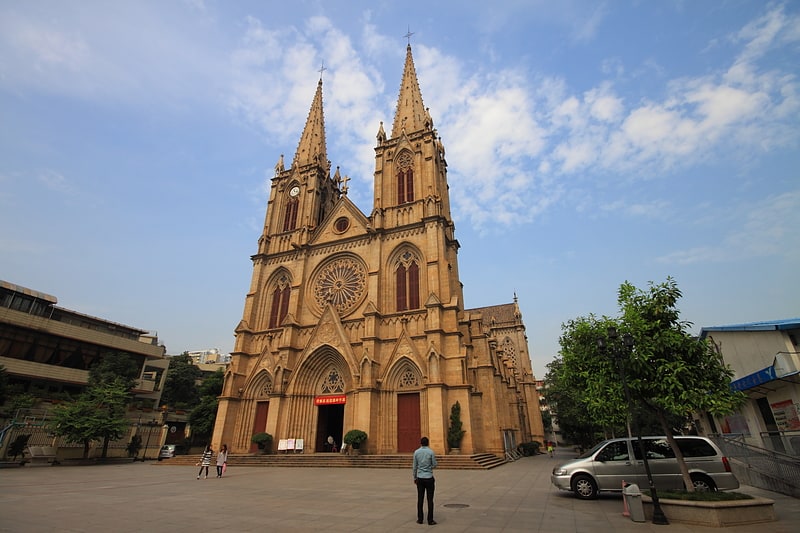
Also known as: 石室圣心大教堂
Gothic-style cathedral completed in 1888. The Sacred Heart Cathedral, properly the Cathedral of the Sacred Heart of Jesus and also known as the Stone House by locals, is a Gothic Revival Roman Catholic cathedral in Guangzhou, China. It is the seat of the Archbishop of Guangzhou. The cathedral is located at 56 Yide Road, on the north bank of the Pearl River at the heart of the old town. It is one of the few cathedrals in the world to be entirely built of granite, including all the walls, pillars, and the twin towers.[1]
Chen Clan Ancestral Hall
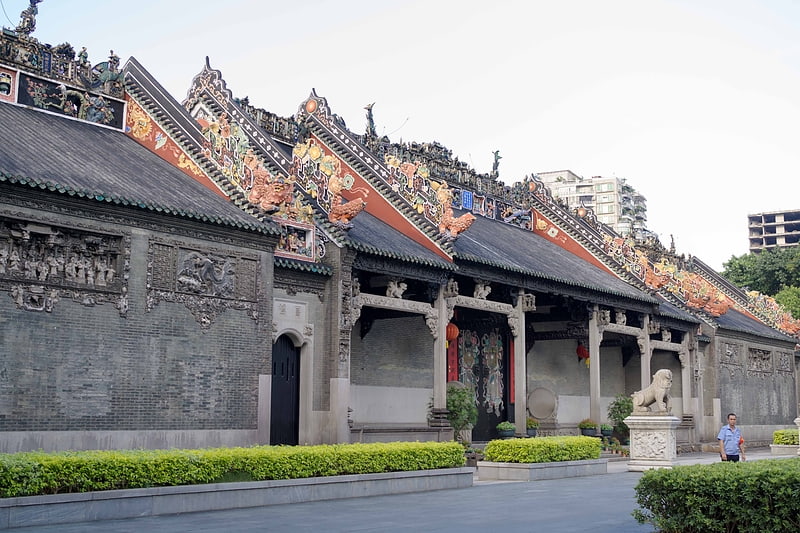
Also known as: 陈家祠
Museum in Guangzhou, China. The Chen Clan Ancestral Hall or Chen Clan Academy is an academic temple in Guangzhou, China, built by the 72 Chen clans for their juniors' accommodation and preparation for the imperial examinations in 1894 in Qing Dynasty. Later it was changed to be the Chen Clan's Industry College, and then middle schools afterward. Now it houses the Guangdong Folk Art Museum.
Located at Zhongshan 7th Road beside the Chen Clan Academy metro station, the Chen Clan Ancestral Hall is a symmetric complex consist of 19 buildings with nine halls and six courtyards. Facing south, the complex forms around a north-south axis. A large collection of southern China art pieces, such as wood carvings and pottery, can be found in the structure. The Chen Clan Ancestral Hall complex exemplifies traditional Chinese architecture and decoration style, and has influenced cultural and architectural developments worldwide. It was added in the list of "Cultural Relics of National Importance under the Protection of the State" in 1988.[2]
Address: Zhongshan 7th Road (中山七路), Guangzhou
Temple of the Six Banyan Trees
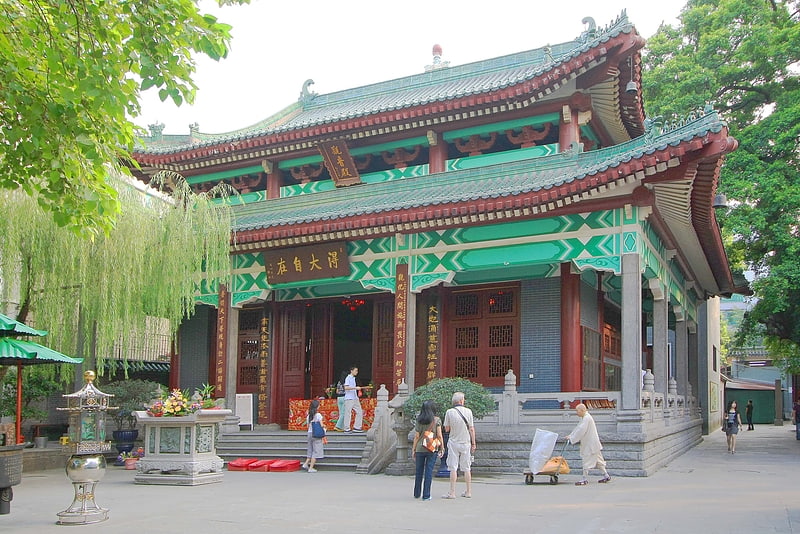
Also known as: 六榕寺
Ancient Buddhist temple complex. The Temple of the Six Banyan Trees or Liurong Temple is a Buddhist temple in Guangzhou, China, originally built in AD 537.
The temple's proximity to foreign consulates in Guangzhou has made it a regular destination for families participating in the international adoption of children from China. Typically families receive blessings for their newly adopted children at this temple in front of the statue of Guanyin.[3]
Address: 87 Liurong Rd (六榕路), Guangzhou
Peasant Movement Training Institute

Also known as: 广州农民运动讲习所
School. The Peasant Movement Training Institute or Peasant Training School was a school in Guangzhou, China, operated from 1923 to 1926 during the First United Front between the Nationalists and Communists. It was based in a 14th-century Confucian temple. The site now houses a museum to Guangzhou's revolutionary past.[4]
Address: No. 42 Zhongshan Fourth Road, Yuexiu District, 511470 Guangzhou
Our Lady of Lourdes Chapel
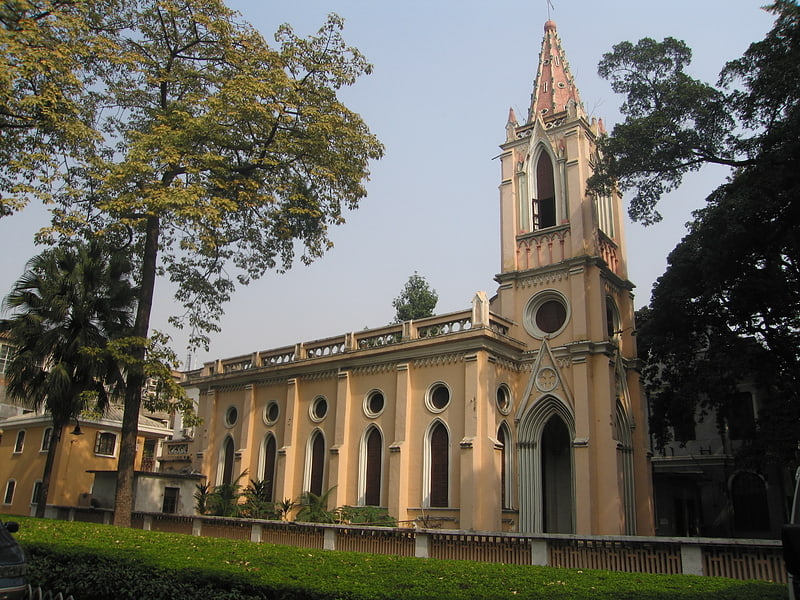
Church in Guangzhou, China. The Our Lady of Lourdes Chapel, Shamian Island is a 20th-century gothic church. It is located in Shamian, Liwan District of Guangzhou, Guangdong, China.[5]
Shamian Christian Church

Shamian Christian Church is a Protestant church located in Shamian, Liwan District of Guangzhou, Guangdong, China.[6]
Yuexiu Hill
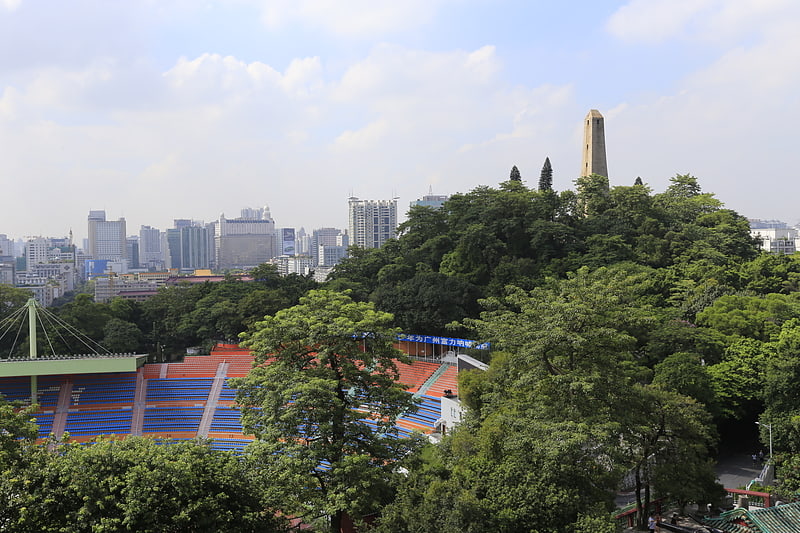
Also known as: 越秀山
Yuexiu Hill, also known as Yut Sau Shan,Yut Sau Hill or Mount Yuexiu, is located in Yuexiu District, Guangzhou. It once formed the northern end of the old walled city, though most of the walls have been dismantled and the city has now expanded far beyond it. Its grounds now form Guangzhou's Yuexiu Park, which remains one of the most famous tourist attractions in Guangzhou, including beautiful natural surroundings and ancient sites. It covers an area of 860,000 square meters.[7]
Address: No.988 Jiefang North Road, Yuexiu District, Guangzhou
Canton Tower
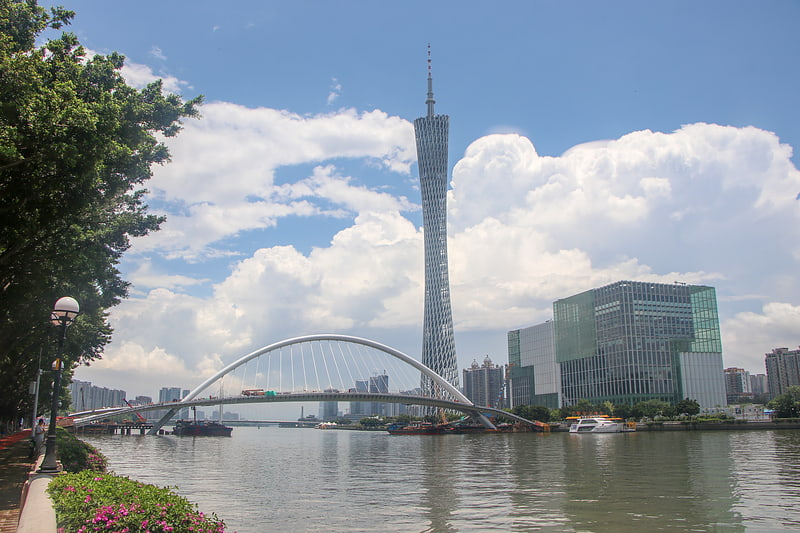
Also known as: 广州塔
604-m. tower with a rooftop viewing deck. The Canton Tower, formally Guangzhou TV Astronomical and Sightseeing Tower, is a 604-meter -tall multipurpose observation tower in the Haizhu District of Guangzhou. The tower was topped out in 2009 and it became operational on 29 September 2010 for the 2010 Asian Games. The tower briefly held the title of tallest tower in the world, replacing the CN Tower, before being surpassed by the Tokyo Skytree. It was the tallest structure in China prior to the topping out of the Shanghai Tower on 3 August 2013, and is now the second-tallest tower and the fourth-tallest freestanding structure in the world.[8]
Museum of the Mausoleum of the Nanyue King
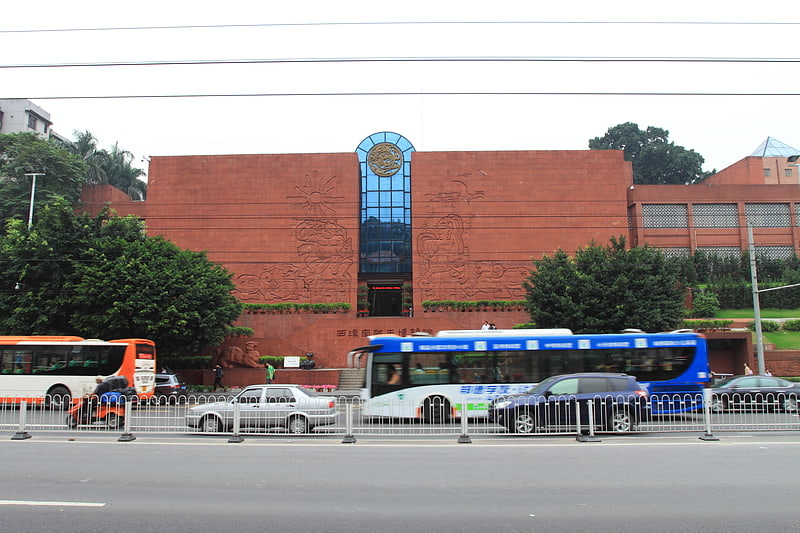
Also known as: 西汉南越王博物馆
Museum in Guangzhou, China. The Museum of the Western Han Dynasty Mausoleum of the Nanyue King houses the 2,000-year-old tomb of the Nanyue King Zhao Mo in Guangzhou. Zhao Mo ruled from 137 BC to 122 BC, and his tomb was discovered in downtown Guangzhou in 1983. The museum, which opened in 1988, showcases the tomb and its complete trove of artifacts. It was named a Major National Historical Site in 1996 and is renowned for its rare assemblage of funerary artifacts representing the diffusion of cultures throughout the Lingnan region during the Han dynasty.[9]
Address: 867 Jiefang Road N. (解放北路878号), Guangzhou
Dafo Temple

Also known as: 大佛寺
Temple in Guangzhou, China. The Dafo Temple is a Buddhist temple in Guangzhou, Guangdong, China. Located in Yuexiu District, Dafo Temple is a grand temple with a history of more than one thousand years and was built by Emperor Liu Yan in the Southern Han dynasty. It has been praised as one of the "Five Largest Temples of Guangzhou" in history. Later it was destroyed and rebuilt many times. In the late Ming dynasty, the temple was declining day by day and was devastated by the war while Shang Kexi and Geng Jimao conquered Guangdong in 1649. During the reign of the Kangxi Emperor in 1663, the temple was rebuilt and expanded by Shang Kexi continuously. According to the national policy of free religious belief, the temple was approved by the Guangzhou Municipal People's Government to be restored as a Buddhist temple in 1981. Then Master Guangming, vice-president of the Guangzhou Buddhist Association, served as abbot; he tried to revitalize Dafo Temple and restore the style of the large temple. On August 9, 1993, Dafo Temple was put on the list as a Municipality Protected Historic Site by the Guangzhou Municipal People's Government.[10]
Zhenhai Tower
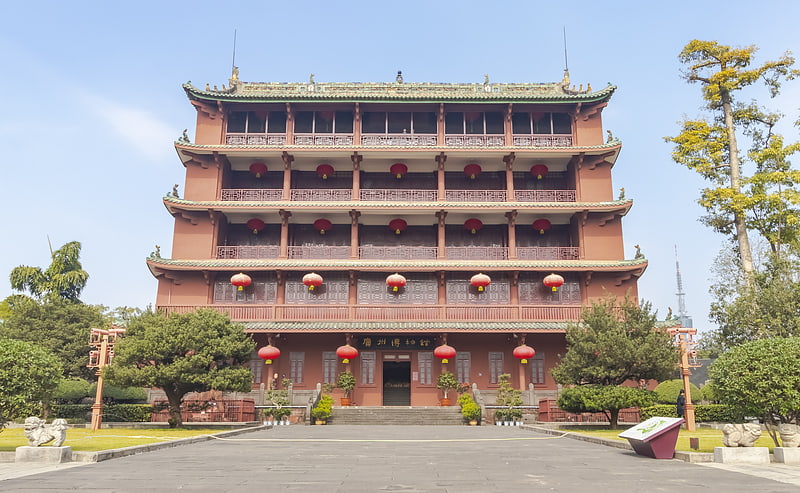
Also known as: 镇海楼
The Zhenhai Tower, also known as the Five-Story Pagoda, is a tower in Guangzhou, Guangdong. It is located in Yuexiu Park, in central Guangzhou. It now houses the Guangzhou Museum.[11]
Guangxiao Temple
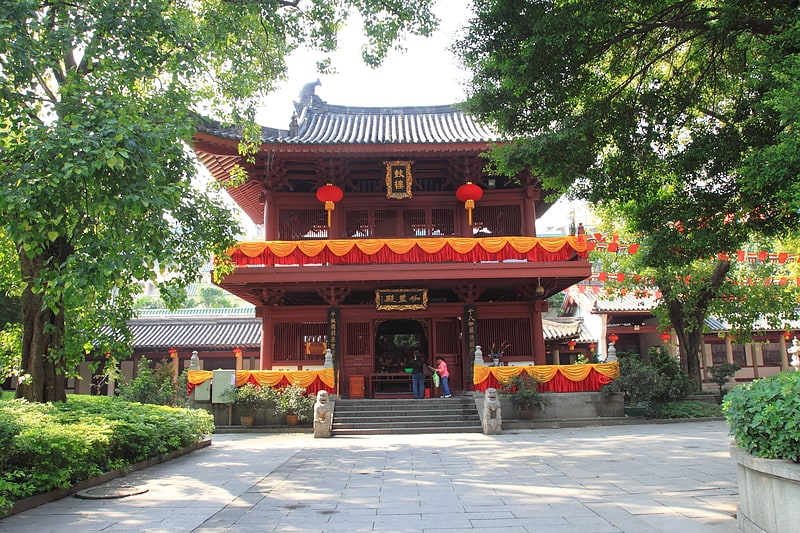
Also known as: 光孝寺
Buddhist temple in Guangzhou, China. Guangxiao Temple is one of the oldest Buddhist temples in Guangzhou, the capital of China's Guangdong Province. As the special geographical position, Guangxiao Temple often acted as a stopover point for Asian missionary monks in the past. It also played a central role in propagating various elements of Buddhism, including precepts school, Chan, Shingon Buddhism, and Pure Land. In this temple, Huineng, the sixth Chinese patriarch of Chan Buddhism, made his first public Chan lecture and was tonsured, and Amoghavajra, a Shingon Buddhist master, gave his first teaching of esoteric Buddhism. Many Buddhist scriptures were also translated here, including those translated by Yijing and the Shurangama-sūtra translated by Paramitiin.[12]
Address: 109 Guangxiao Rd | 光孝路109号, 510180 广州
Baiyun Mountain
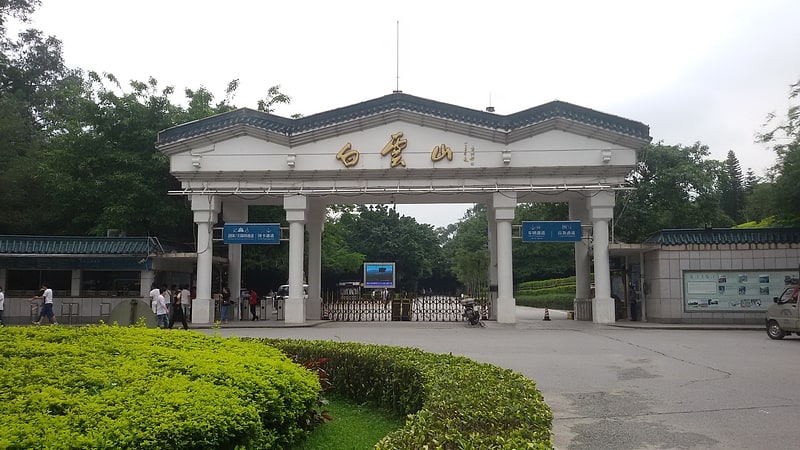
Also known as: 白云山
Mountain in China. Baiyun Mountain, also known as White Cloud Mountain, is a mountain located a few miles to the north of Guangzhou, China. It has a height of 427 metres.[13]
Guangzhou Opera House
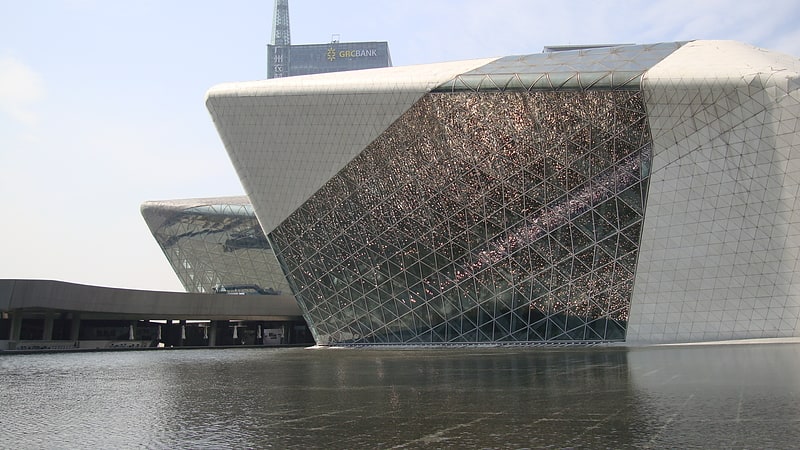
Also known as: 广州大剧院
Opera house in Guangzhou, China. Guangzhou Opera House is a Chinese opera house in Guangzhou, Guangdong province, People's Republic of China. Designed by Zaha Hadid, it opened on 9 May in 2010.[14]
Address: 1 Zhujiang W Rd | 珠江西路1号, Guangzhou
Hoi Tong Monastery
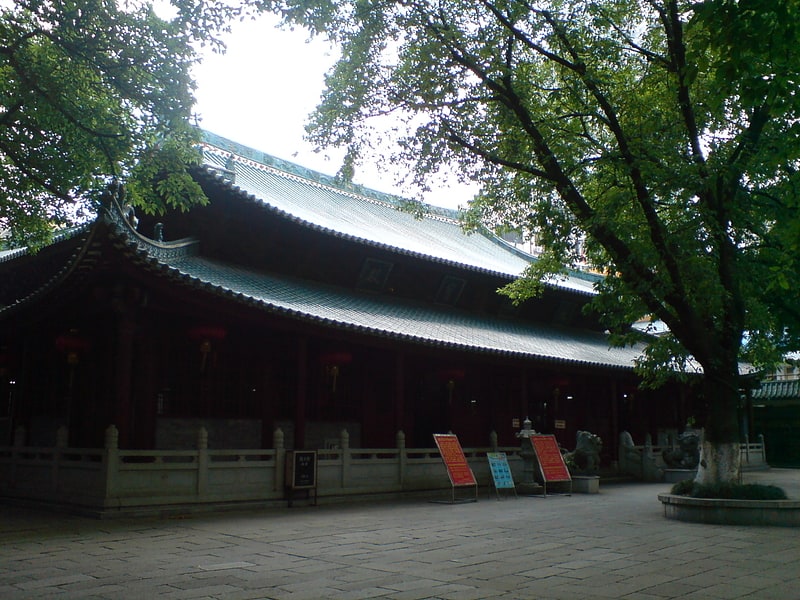
Also known as: 海幢寺
Buddhist temple in Guangzhou, China. The Hoi Tong Monastery, also known by many other names, is a Buddhist temple and monastery on Henan Island in Guangzhou, China. It shares its grounds with the city's Haichuang Park.[15]
Huaisheng Mosque
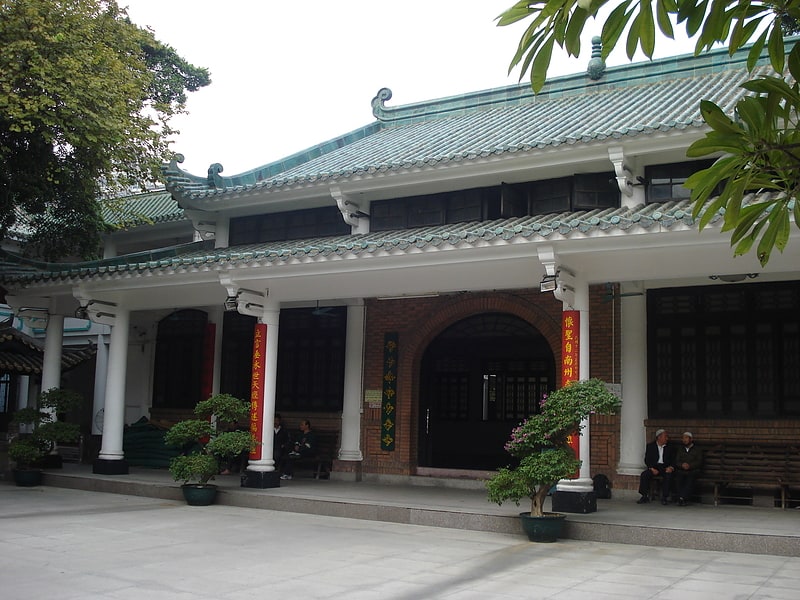
Also known as: 怀圣寺
Mosque. The Huaisheng Mosque is the main mosque of Guangzhou. Rebuilt many times over its history, it is traditionally thought to have been originally built over 1,300 years ago, which would make it one of the oldest mosques in the world.
In China, the most unusual feature of the mosque is its pointed 36 metre minaret, the Guangta or Kwangtah. Although this meant the "Plain Pagoda" in reference to its unadorned surface, it is also sometimes taken to mean "lighthouse" and gave the mosque its alternate name. Somewhat similar "minimalist" minarets can be seen outside China, e.g. at the Khan's Mosque in Kasimov, Russia. The mosque was visited by Tim Severin's crew of the Sohar, that sailed into Canton from Muscat in July 1981, recreating the fictional voyage of Sinbad the Sailor.[16]
Address: 56 Guangta Rd (光塔路), Guangzhou
Tianhe Church

Christian Church of Guangzhou Tianhe, also known as Tianhe Church, is a Christian TSPM Church in Guangzhou, China. It is located at No. 16-20 Daguan Middle Road, Tianhe District, and hence its name. It is considered the largest church in Guangzhou.
Tianhe Church is the first Christian church built in Guangzhou after 1949, and is the first church in Tianhe District. The predecessor of the church was Xiaogang Church (小港堂) in Haizhu District. Since the church was seriously damaged, it was rebuilt in another place. On September 15, 2007, the foundation stone ceremony of the new church was held, and the construction started on February 10, 2009. It was finally opened on January 14, 2017 officially.[17]
Haizhu Bridge
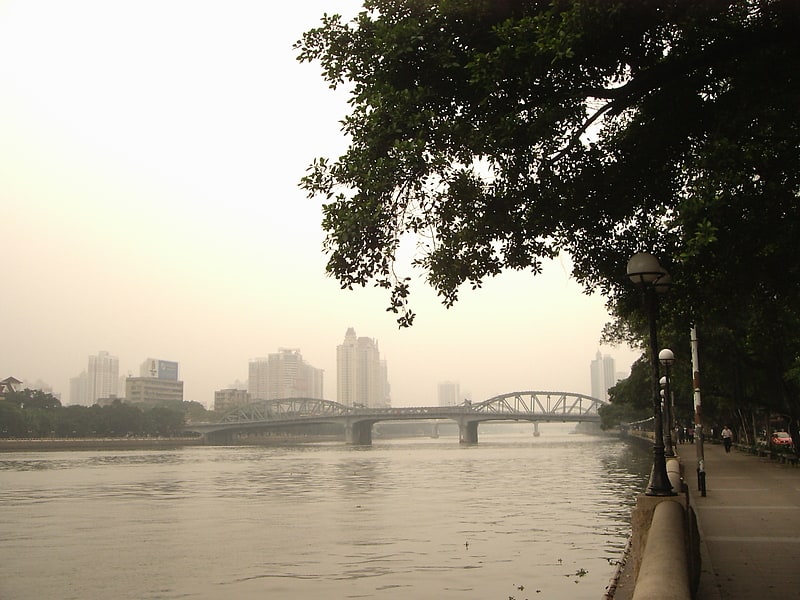
Also known as: 海珠橋
Truss bridge in Guangzhou, China. Haizhu Bridge is an iron bridge across the Pearl River in Guangzhou, China.
The bridge runs from Haizhu Square in Yuexiu District, and south towards Jiangnan Avenue in Haizhu District.
Haizhu Bridge was the first bridge to be built across the Pearl River in Guangzhou. Work started in 1929 and ended in 1933, and was completed by the American contractor Markton Company.
The bridge was damaged by the Japanese in 1938, and again in 1949 by retreating Kuomintang forces.
Today the bridge carries a two-lane, bidirectional road connecting the north and south banks of the Pearl River.
In 2009, the bridge gained notoriety when a number of people threatened suicide by jumping off the bridge.[18]
People's Park
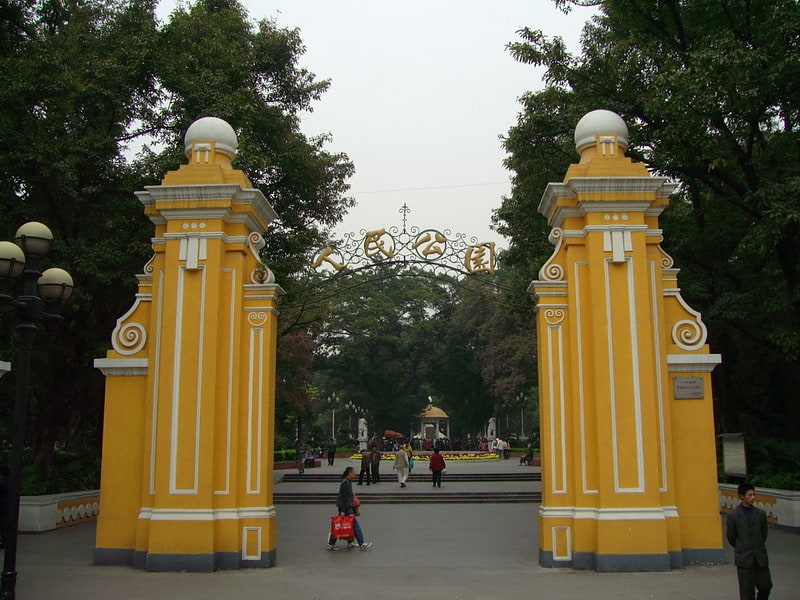
Also known as: 人民公园
Park in Guangzhou, China. People's Park is an urban public park in Yuexiu District in central Guangzhou, capital of Guangdong province in south China. Established in 1921, it is the first public park in the city, built on the site that had been the location of successive regional governments since the Sui dynasty. Due to its central location, it is colloquially called Central Park.[19]
South China Botanical Garden
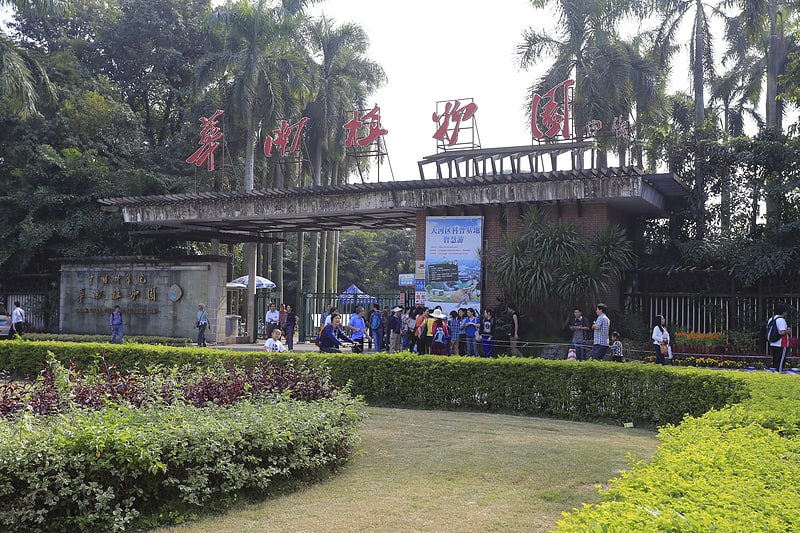
Also known as: 中国科学院华南植物园
Botanical garden in Guangzhou, China. The South China Botanical Garden of the Chinese Academy of Sciences is a large botanical garden in Guangzhou, Guangdong province in southern China.[20]
Guangzhou Martyrs' Memorial Garden
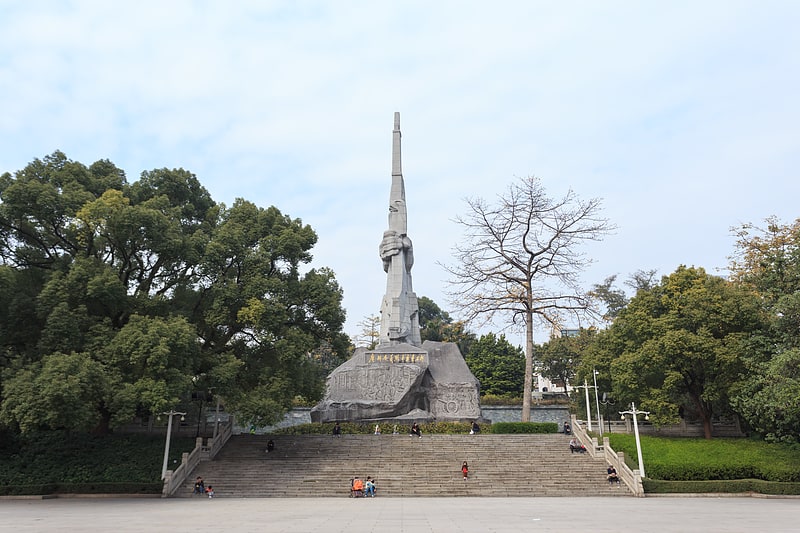
Park in Guangzhou, China. Guangzhou Martyrs' Memorial Garden is a park located in Zhongshan 3rd Road, Guangzhou, Guangdong, China that commemorates the death of the Chinese Communist party in the Guangzhou Uprising against the Kuomintang on December 11, 1927.[21]
Address: Zhongshan 2nd Road (中山二路), Guangzhou
Chigang Pagoda
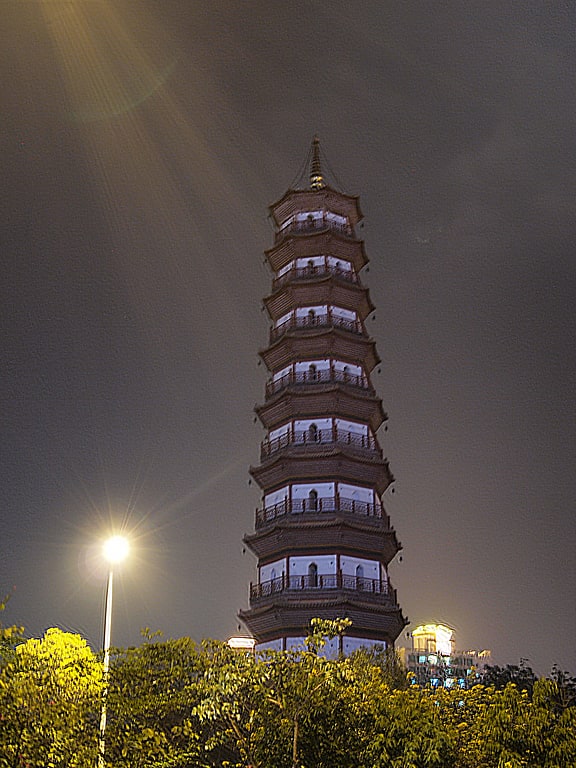
Also known as: 赤岗塔
Chigang Pagoda, also known as the Red Stone Hill Pagoda or Honam Pogoda, is a famous pagoda located in Haizhu District, Guangzhou, China.[22]
Hualin Temple
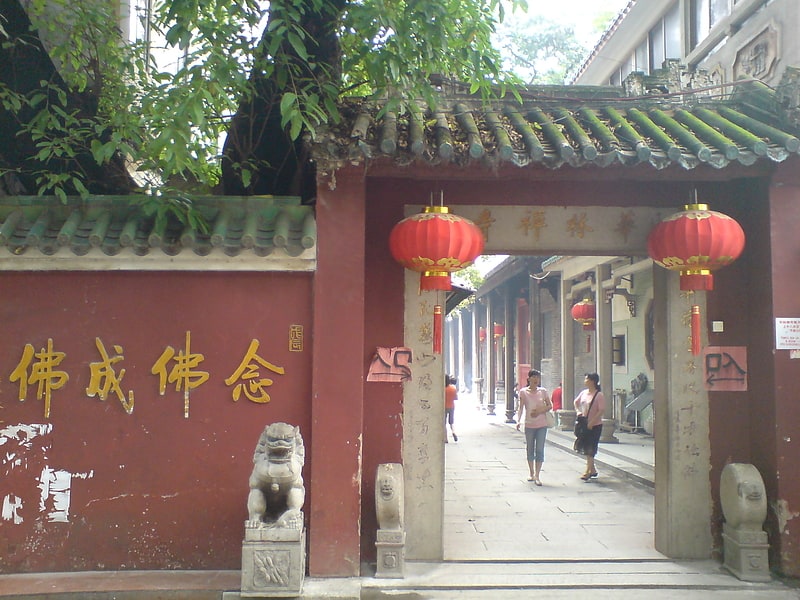
Also known as: 华林寺
Hualin Temple, also known as the Temple of the Five Hundred Genii or Gods, is a Buddhist temple in Guangzhou, China.[23]
Temple of the Five Immortals
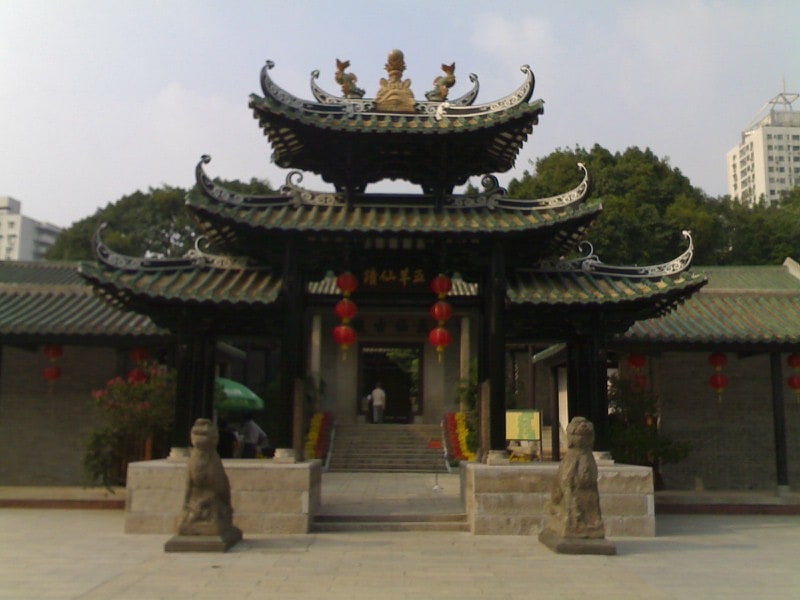
Also known as: 五仙观
The Temple of the Five Immortals, formerly translated as the Temple of the Five Genii, is a Taoist temple in Guangzhou, Guangdong, in China. It lies beside the junction of West Huifu Road and Liurong Rd.[24]
Address: Huifu West Road (惠福西路), Guangzhou
Guangdong Museum
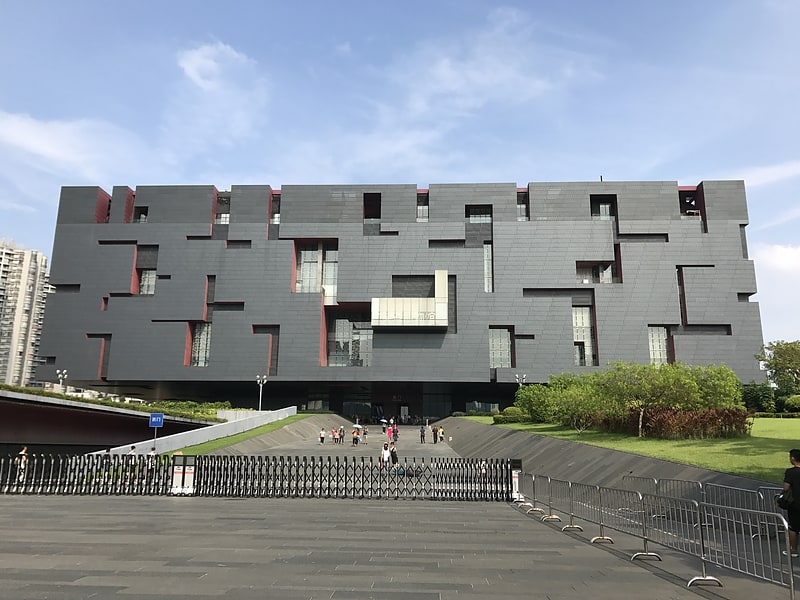
Also known as: 广东省博物馆
Museum in Guangzhou, China. The Guangdong Museum is a general museum of Cantonese art, nature, culture and history in Guangzhou.[25]
Canton Fair Complex
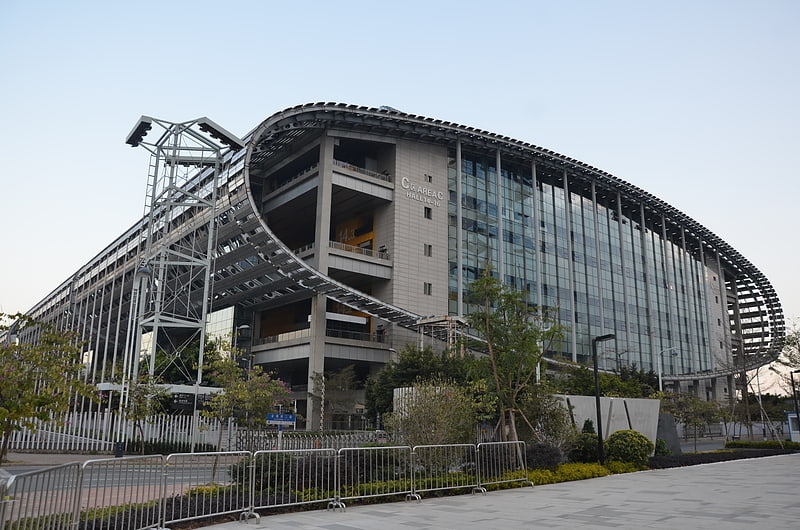
The Canton Fair Complex, formerly known as Guangzhou International Convention and Exhibition Center, is located on Pazhou Island in the Guangzhou in the People's Republic of China. It is possibly the largest convention center in the world at 12,174,000 sq ft, and also contains the world's largest exhibition hall at 1,700,000.5 sq ft.
Interwine is held here.[26]
Yuexiushan Stadium
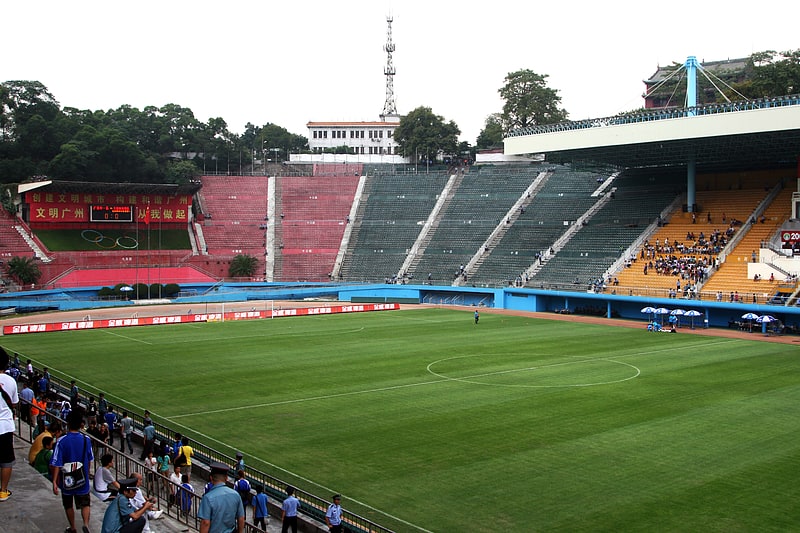
Also known as: 越秀山体育场
Multi-purpose stadium in Guangzhou, China. The Yuexiushan Stadium is a multi-purpose stadium in Guangzhou, Guangdong, China, named for its location at the foot of Yuexiu Hill. It is currently mostly used for football matches and also sometimes for athletics. It is located on 4 Yingyuan Road. The stadium is owned by the Guangzhou Sports Bureau.
The original stadium at the same location opened before 1926. In 1950, it was completely rebuild with a capacity for 35,000 people. However, following renovation and the installation of fixed seating in 2012, the capacity is now 18,000.
The stadium is best reached by taking Guangzhou Metro Line 2 to Sun Yat-Sen Memorial Hall Station.[27]
Address: No.34-36 Yingyuan Road, Yuexiu District, 510045 Guangzhou
Haiyin Bridge
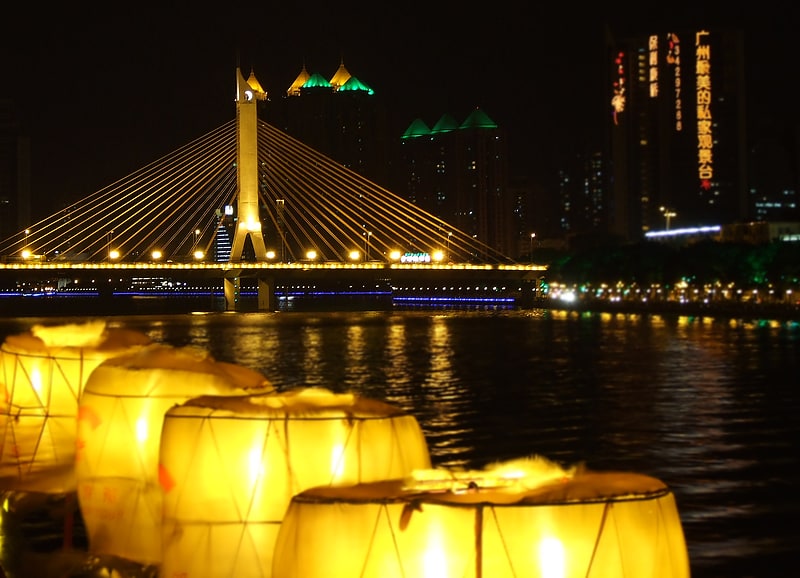
Also known as: 海印大橋
Bridge in Guangzhou, China. Haiyin Bridge is a bridge crossing the Pearl River in Guangzhou, China.
The double tower single plane cable stayed bridge was completed in 1988 and connects Haizhu District with Yuexiu District.[28]
Address: Haiyin Bridge 海印大桥, Guangzhou
Wong Tai Sin Temple

Also known as: 黄大仙祠
Place of worship in Guangzhou, China. Wong Tai Sin Temple is a major tourist attraction dedicated to Chinese deity Wong Tai Sin. Situated in the Huadi Subdistrict, Liwan District of Guangzhou, it is a Taoist temple. It is just one of many temples dedicated to Wong Tai Sin. Besides, it can be found in different parts of the world, including China, Southeast Asia, and the United States, etc. Among them, the oldest one is in Jinhua City, Zhejiang Province, China.[29]
Address: Guci Road, Liwan District, 510375 Guangzhou
Pazhou Pagoda
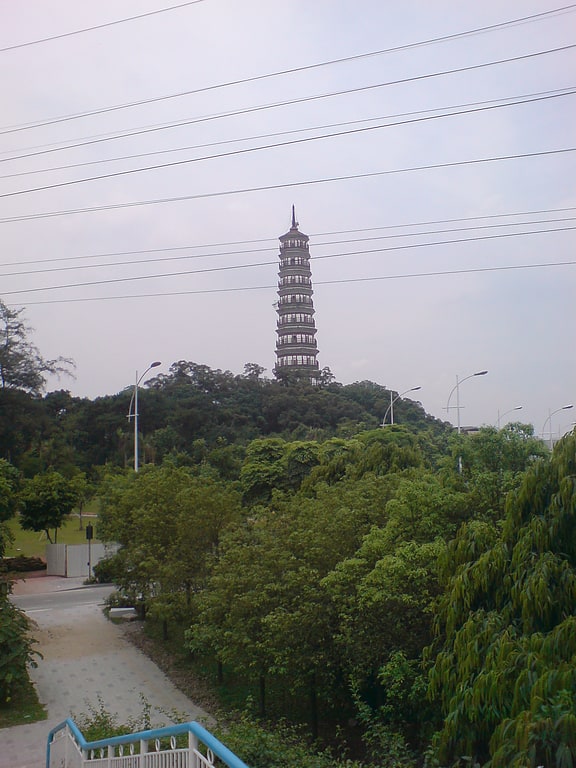
Also known as: 琶洲塔
Tourist attraction in Guangzhou, China. The Pazhou Pagoda, also known as the Whampoa Pagoda or Pa Chow Pogoda, is an early modern Chinese pagoda on Pazhou Island in Haizhu District, Guangzhou, the capital of China's Guangdong Province.[30]
Jiangwan Bridge

Also known as: 江湾大桥
Beam bridge in Guangzhou, China. Jiangwan Bridge is a bridge crossing over the Pearl River in Guangzhou, Guangdong, China. Guangzhou's Inner Ring Road runs across the Bridge, connecting the Haizhu District with the Yuexiu District.
On the northern bank of Jiangwan Bridge is Dashatou wharf, one of the main passenger wharves in Guangzhou's extensive river passenger transport system.
Immediately to the west of the Haizhu ramp of the bridge sits Dabenying, one of many former residences of Sun Yat-sen, himself a native of Cuiheng, part of then Canton (Guangzhou) prefecture. Today the mansion is open to the public and serves as The Memorial Museum of Generalissimo Sun Yat-sen's Mansion.[31]
Sun Yat-sen Memorial Hall

Also known as: 中山纪念堂
The Sun Yat-sen or Zhongshan Memorial Hall is an octagon-shaped building in Guangzhou, capital of China's Guangdong Province. The hall was designed by Lu Yanzhi and was built with funds raised by local and overseas Chinese people in memory of Sun Yat-sen. Construction work commenced in 1929 and completed in 1931. The hall is a large octagonal structure with a span of 71 meters without pillars, housing a large stage and seats 3,240 people.[32]
Jiefang Bridge

Also known as: 解放大桥
Bridge in Guangzhou, China. Jiefang Bridge is a bridge in Guangzhou, China. The bridge connects the Haizhu District with the Yuexiu District, and is one of nine bridges connecting Haizhu with downtown Guangzhou and the business districts. On its north side is Jiefang South Rd and on its south side is Tongqing Rd.
Guangzhou's annual Dragon Boat Race takes place between Jiefang Bridge and Renmin Bridge.[33]
Liwan
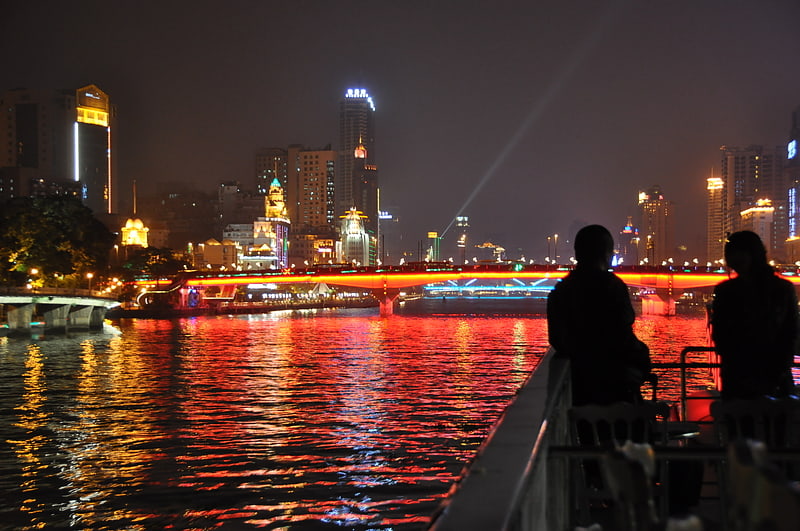
Liwan District is one of 11 urban districts of the prefecture-level city of Guangzhou, the capital of Guangdong Province, China. The district is split into two parts by the Pearl River: Xiguan in the northeast and Fangcun in the southwest.[34]